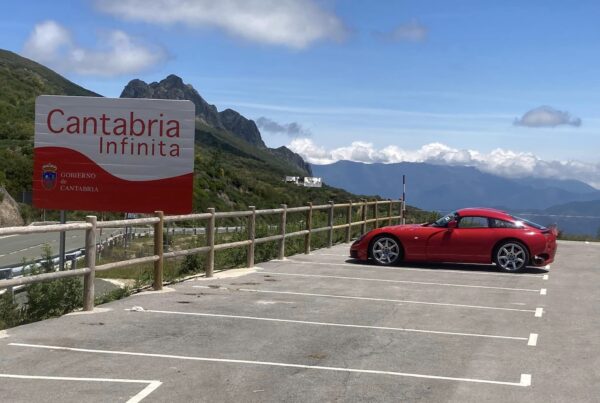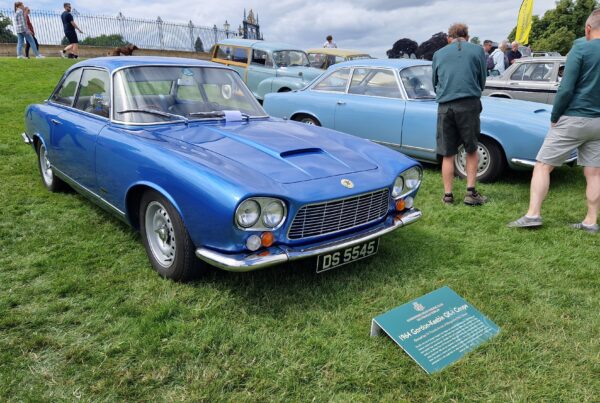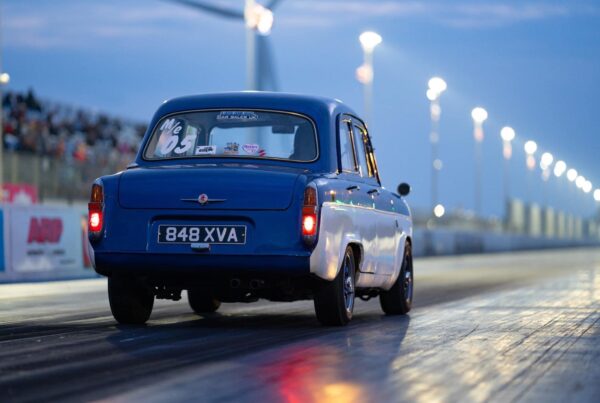If you are familiar with the cars that Andy Saunders has built over the years, you may well wonder where the inspiration comes from for such radical and unique builds. Each car is full of wild creativity, techniques, and skills that push the boundaries of customisation.
Take the Tetanus Cord for example. As the winner of the ClassicLine pick at the 2022 NSRA Hot Rod Supernationals, this car has been quoted as raising the benchmark of custom cars in the UK. This statement car is elegant and timeless. Yet it is full of evocative expression with a dramatic roof chop, a commanding front end reminiscent of early prototype vehicles, and a sultry two-tone silhouette.
But what were the inspirations for this build that is based on a right-hand drive 812 Cord Westchester Four-Door Sedan?
After the show, we sat down with custom car builder, Andy Saunders, to chat about how the Cord went from a dilapidated barn find to an art-deco inspired custom Coupe.
An unusual history
The Cord had lived quite an interesting life before Andy bought it. Purchased from a lady in 2003, the car came with some original paperwork which shows that it was one of 27 right-hand drive 812 Cords that were made in 1937 for world export. Of the 27, only about 5 or 6 vehicles actually made their way to the UK.
It was bought new by the Earl of Derby in 1937/38 from Auburn, Cord, and Duesenberg dealer R.S.M Automobiles in London’s Berkeley Square. No one knows how long the Earl kept the car, but the paperwork Andy found suggests that the car was 13 or 14 years old when it started to suffer from gearbox problems – which was a common fault due to the unusual electronic selector setup.
The second owner of the car was a Polish stock car driver, Jerzy Wojtowicz. Andy managed to name the famous racer with help from Julius Thurgood of Top Hat Racing and Goodwood Revival. Wojtowicz was credited as being one of the highest awarded WWII Polish pilots and after the war, took his skills to the stock car racing track eventually becoming a world champion.
But after Jerzy acquired the Cord, the trail went cold….
The Cord still had its wings attached to the body, and none of the doors had been welded up which would suggest that the car was not actually used for stock car racing. However, and unusually, it was rear wheel drive model, and had a Ford Flathead under the bonnet with an Austin Devon rear axle.
A lot of confusion surrounded the cars past.
After Andy debuted the car in 2017, the Tetanus Cord appeared in Street Machine Magazine. Off the back of the feature, the magazine editor received a phone call from the writer of the Time Traveller column in Stock Car Magazine, an aficionado of historic stock car racing. Through this contact, Andy was able to fill in some of the gaps in the car’s history.
The historian knew Jerzy Wojtowicz raced or prepared an Auburn for the world championship in Australia in 1957 but was under the impression that it was powered by a Cord engine. Though they never had any proof of this as the car never actually raced.
Jerzy Wojtowicz had an Auburn 831 with a cast iron straight-eight engine which was prepared for racing. This car was too heavy on the nose and did not go into corners well. The historian had been able to ascertain that the engine and gearbox were taken out of a Cord, converted to front wheel drive, and exported to Australia towards the end of 1956. Once transplanted into the Auburn, Wojtowicz used this modified Auburn on the track in preparation for the world championships that year. It wasn’t long before the car suffered gearbox issues. Uncertain if the car would be suitable for the world championships, Wojtowicz chose to race a friend’s car. Unfortunately, things didn’t end well. The car barrel rolled and hit two cars upon landing. Wojtowicz was so badly injured that he never regained his ability to race, with the Auburn with Cord engine and box remaining out in Australia.
Andy says he was able to back up this story through a picture provided by the historian. The picture shows an Auburn on the startline sporting Jerzy Wojtowicz’s race number 99, with Cord front wheels. Interestingly, Cord front wheels will not fit anything other than a Cord.
Back in England, the Flathead powered Cord ended up on the Yorkshire Moors for about 30 years where it was used as a climbing frame and sadly vandalised. The car was then bought by the son of the lady whom Andy purchased the car from for a considerable amount of money with a view to restore it. Once the son realised what a dilapidated condition the car was in, the project was scrapped, and the car was left to rot. The car was then for sale for 10 years and Andy says he was the only person with a big enough dustpan and broom to pick it up!
Andy made an offer of £500 to which the lady replied, “you must be joking” and thinking it was worth thousands – even in this condition. Andy was then proudly told that Bonhams were viewing the car the following week for one of their unrestored auctions. Bonhams visited and quickly departed. Andy then received a call to ask if his offer still stands and Bonhams had said that it was “unfair to try and move it from its resting place”. A gentle thanks but no thanks!
I’m not touching that without a “Tetanus”!
Andy bought the car in 2003 and assisted by friend, Colin Ware from Kustom Kolours, the pair went to collect the car, stopping off on the way back to spend the weekend at the NSRA Hot Rod Supernationals.
When Andy opened the barn door, Colin exclaimed that he was not touching “that” without having a tetanus shot! The name was born, and the car was affectionately known as “Tetanus” for evermore. But almost 15 years would pass before the Cord would make an appearance at the Supernationals again…
How do you rebuild a rusty shell?
At the start, Andy was unsure of the direction of this build, his only thoughts being that he was never going to get another Cord cheap enough to radically customise. In fact, he actually didn’t know there was a Ford Flathead under the bonnet. The bonnet was stuck closed, the driver’s side was tightly wedged against the barn wall, and the passenger door had rusted closed.
Once at the Supernationals, Andy and Colin managed to get into the car and open the bonnet, only to find it had none of its original running gear. It was at this point he was pleased not to have paid more than £500 for this rusting heap!
The first inspirational idea came when Andy got the passenger doors to open… with a sledgehammer! The metal had rusted to the point that doors ripped the B pillar away as they came open. It was at this moment Andy thought of making this mordor into a Coupe.
The art of customisation
The car was stripped down to a shell. The floor panels pushed out by hand as they were so rusty. The bare shell went for shotblasting and as expected, it came back with very little left. The roof was salvageable, the front end came off, but the grille was beyond repair. It was quite a sorry sight.
Andy managed to use 2/3 of the original Cord chassis up to the area under the back wheel arch. A Jaguar rear floor pan with mountings was then used for the back section. Once the saloon body was secured back onto the stronger chassis, it was time to get roof chopping to achieve the Coupe shape.
As well as creating a Coupe shape, the front bonnet and grille of the car differ from the original too. During the build, Andy got to know Stan at ACD in the States, an Auburn, Cord, and Duesenberg spares supplier. Stan supplied a replacement grille and many other reproduction parts, including the dashboard.
But something rather special happened when Stan saw picture of the Cord.
Asking Andy if he had seen a Cord 814 before, to which the answer was no, Stan went on to describe the 814-prototype model designed by Alex Tremulis. Tremulis was a very clever guy, designing vehicles such as the Tucker Torpedo and the X-2000, another of Andy’s famous custom recreations. As a young man, Tremulis worked for Gordon Behring, eventually ending up as head honcho at Auburn, Cord, and Duesenberg before the business went bankrupt during the great depression. In 1938, a new Cord model was prototyped, the 814. Despite never going into production, Stan delighted in telling Andy that he’d unknowingly recreated the front of the Cord 814.
Another key inspiration was an art deco streamliner Pebble Beach Concours de Elegance trophy. Andy incorporated inspirational elements of the trophy into the build in areas such as the long swooping door handles, and the low sloping roof. Imagine the blind spot!
Powering the Tetanus Cord
The Ford Flathead was removed, and a 350 Chevy implanted. Working with this is a front cross member from MKII Jaguar and a rear axle from a 1992 Jaguar.
Inside the car, the dashboard has been fully restored and the dials refurbished by Adrian Sidwell. The front seat is a bench seat. Andy tells us that it looks original, but it is a foot lower than it would have been originally to allow for the roof chop.
On the exterior, the paint is two-tone grey Fiat 500 Abarth colours, and you may be surprised to learn that the paint scheme was inspired by a greetings card spotted in a garden centre! The card had three cars on the front, one of which was an art-deco style car in purple and orange. Yes, you heard that right… But Andy had never seen such an unusual a break line where the paint comes down the roof pillars and then stops, and it was in this moment that Andy knew what paint scheme the Cord was going to have. This greetings card was another inspiration of the build and Andy keeps the card with the car’s history file.
Personalising the custom Coupe
Shortly after Andy’s dear Mum passed away, he visited a crystal shop in Glastonbury where he spotted a scarab beetle necklace engraved in quartz crystal. Andy picked up the necklace and went into a “design mode” trace, conjuring ideas of how he could use it on the Cord. Egyptology features heavily during the art-deco period, so a conversation with the shop owner led to two cut crystal scarab beetles being custom made, both with a hook so they could be inset with a gold plated back into the back of the bench seat.
There are other personal touches are to be found inside the car. In the roof headlining, there are four aviation-style switches made from diamante encrusted cufflinks and a switch panel from an aeroplane. On the door cards, Tetanus is hand embroidered into the upholstery.
7,000 hours later and the Tetanus Cord is reborn
Including the work that Dave Harris and Paul Burnham did on the car, it totals about 7,000 hours over a period of 14 years. Work on the car did pause for a few years, and of course, when you cut a roof into 30 pieces, you do need to stay focused!
Roof chopping is something that Andy really enjoys, and over the years he’s performed many ‘chops. It is how you hone your fabrication skills, by cutting things up and putting them back together, Andy tells us. A great example of this skill is with the three custom Mini’s that Andy built. The original Mini Ha Ha built in 1983 when Andy was aged 19, took five months to build, and was Andy’s first car to appear on Top Gear. The next Mini built in 2000, only took six weeks, and the third, simply through repetition, took just four days!
The Cord was unveiled at the 2017 NSRA Hot Rod Supernationals to an excited crowd of participants and press. Since the grand unveiling, the Tetanus Cord appeared on display at Beaulieu Motor Museum for three months in 2018. With the lockdowns and other projects, including Maxime’s Angelina Icon Ford Pop, the Cord hasn’t been out much until summer 2022 when it was brought back to the NSRA Hot Rod Supernationals.
Speaking of unveilings, there’s a new project…
Andy is proud to reveal to us that a new custom build is soon to be unveiled, an art deco streamliner!
Based on a Riley RM, this latest creation is a 2-seater roadster with a custom body, a long swooping bonnet and boot lid, painted in metallic lavender. It will make the Tetanus Cord look like a Luton Van! Andy credits the Delehaye 165 Figoni-Falaschi and the Delehaye 175 S Saoutchik, as owned by Diana Dors, as inspirations for this custom car, so we expect it to be spectacular!
Andy is hoping to launch the Riley at the NEC Classic Motor Show in November, along with his new book, but being a streamliner, it requires a fair amount of space! So, if you are reading this and know of a stand with space to accommodate it, please get in touch.
From humble beginnings
Back in the 70s, every other car was torqued up, so Andy was always surrounded by ‘different’ vehicles. Sightings of Lady Penelope’s Rolls Royce in Bournemouth and watching TV programmes like Batman all contributed to his wild creativity. Andy remembers a family trip to Caister Castle and spotting three customised MKI Capris in the car park, one with a teddy boy mural on the bonnet. 8-year-old Andy took it all in, knowing one day these sightings would turn into something great.
Some cars are still wowing Andy nowadays. His top pick at this year’s NSRA Hot Rod Supernationals was the purple GMC Pick Up owned by Clinton Wildish, a fantastic looking custom pickup with interesting touches such as the spare wheel recessed into the Stepside.
International acclaim
We asked Andy what his favourite build has been over the years and Rainbow Chaser was a clear winner. But he believes his famous build is probably the X-2000 which has appeared in TV commercials and as an exhibit for the Turner Prize. The X-2000 was also invited to the Australian International Motor Show as the press car of 2000 and has taken part in the Concours De Elegance.
When the X-2000 was launched, Andy received an email from Steve Tremulis, Alex Tremulis’ nephew, who was so impressed with the build that he flew to England to photograph the car for a book. As a tribute, and with Steve’s help, Andy has paid homage Alex Tremulis in his upcoming book featuring many unique stories including Tremulis’ 1949 synopsis on the fuel efficiency of a flying saucer as a form of transport. The book also brings fascinating insights of Tremulis’ two-piece vertical space rocket which he designed in 1944 whilst working for the American Airforce. It is unbelievable to think that NASA later adapted Tremulis’ designs for the moon landing rocket 25 years later.
You can read the full story in Andy’s latest book, The Automotive Alchemist. Edited by Roger Attaway, and featuring 1,018 colour photographs, this exciting new book will be released in November 2022.
Inspiring a new generation of customisers
How do you inspire young people to get involved in customising and modifying cars? Andy’s main tip is for everyone to be more accepting of the cars that young people have got. The custom car scene is relatively small, so we need to appeal to more people by welcoming those who have a genuine interest in cars. As an “alternative” car group, whether it’s custom cars, hotrods, classic cars, veteran or vintage vehicles, slammed or hot hatches, car enthusiasts should be banding together to ensure that our way of life continues for years to come.
Andy Saunders, thank you for taking the time to talk to us about the inspiration behind the Tetanus Cord. We cannot wait to catch a glimpse of the new Riley Streamliner and read The Automotive Alchemist.


















